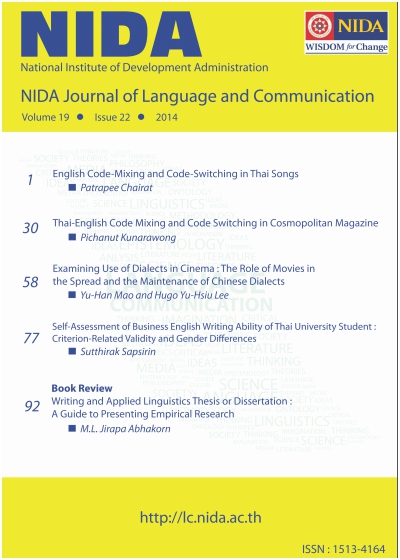Thai-English Code Mixing and Code Switching in Cosmopolitan Magazine
Keywords:
code-mixing, code-switching, magazine, motivationAbstract
A study of Thai-English code mixing and code switching in the Cosmopolitan (“Cosmo”) magazine (Thai edition) aimed: (1) to investigate the different patterns of Thai- English code mixing and code switching in that magazine; (2) to discover the motivations in using Thai-English code mixing and code switching in the magazine; and (3) to discover if Thai-English code mixing and code switching in the magazine can be an alternative way for Thai students to learn English. The entire magazine was used to gain the research data, from the front to the back cover. However, the advertisements published within were not included in the study. The findings of the study reveal that hybridization type code mixing was found at the highest level, followed by truncation, word order shift, conversion, reduplication, and semantic shift respectively. Also, the occurrence of intrasentential code mixing appears to be at its highest when compared with the rest of the nativized features of code mixing and intersentential code switching, but no tag switching is found.
Moreover, the results of the study show that the writers of the magazine applied English words or sentences to a Thai context in order to quote somebody, to repeat for clarification, to fulfill real lexical needs, to use euphemisms, to apply principles of economy, as a convenience to pronounce and to remember, to maintain the feature of the Thai language, to draw the reader’s attention to pictures, to emphasize a key message, to develop meaning, to extend a meaning, to attract the reader’s attention to some specific information, to provide a title for the article, and to express a Western invented concept.
The study also concludes that Thai-English nativized features code mixing are not appropriate for teaching English to Thai students because the linguistic features of the English words were distorted when mixed into a Thai language context. However, code mixing could be applied for teaching examples of incorrect use of the English language; for example, in a comparison with correct usage. Moreover, code mixing at an intrasentential level and intersentential code switching are suitable for Thai students to learn English as English words, phrases, clauses, and sentences have not undergone any modifications. Thus, Thai students could learn how to use the English words correctly which may provide help to the Thai students to improve their communication efficiency.
Downloads
How to Cite
Issue
Section
License
By submitting a manuscript, the author transfers the copyright for the article to School of Language and Communication, National Institute of Development Administration (NIDA), if and when the manuscript is accepted for publication. Though the journal is an open-access, reproduction of any material published in NIDA Journal of Language and Communication for non-personal and/or commercial purpose requires a written permission from School of Language and Communication, National Institute of Development Administration (NIDA).






